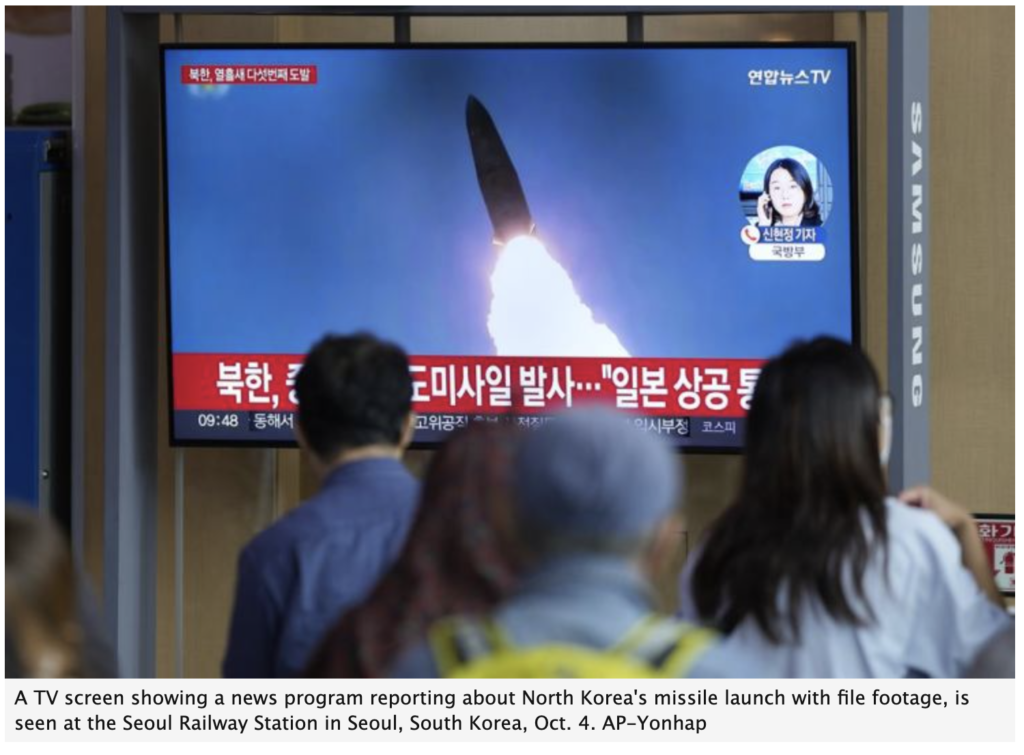
Another missile launch from North Korea, another American aircraft carrier in nearby seas, and the cycle of military confrontation on the peninsula continues. Meanwhile, the latest rocket can reach “not only Japan but also Guam,” home to a US strategic bomber base. All in all, a dangerous situation.
The latest on North Korea’s recent series of missile tests:
North Korea fired two short-range ballistic missiles toward the East Sea on Thursday, South Korea’s military said, after a U.S. nuclear-powered aircraft carrier was redeployed to the waters the previous day.
The Joint Chiefs of Staff (JCS) said it detected the launches from the Samsok area in Pyongyang between 6:01 a.m. and 6:23 a.m. It did not provide other details.
The launches came just two days after the North’s intermediate-range ballistic missile launch over Japan.“While strengthening our monitoring and vigilance, our military is maintaining a full readiness posture in close cooperation with the United States,” the JCS said in a text message sent to reporters.
The USS Ronald Reagan returned to waters east of South Korea after it departed last week following an exercise with the South Korean Navy and then trilateral anti-submarine warfare drills involving Japan.
The carrier is expected to engage in another trilateral exercise with Japan in the international waters of the East Sea later in the day. (Yonhap)
Lots of angst and stiff warnings from Washington and Seoul and a tough response of missile drills. But Hankyoreh puts a key issue front and center: the U.S. nuclear armada in Guam.
The [latest North Korean] missile is believed to have been a Hwasong-12, which was previously mentioned in the Guam strike plan that North Korea disclosed in summer 2017. First unveiled at a North Korean military parade on April 15, 2017, the Hwasong-12 is an IRBM that uses liquid fuel as a propellant.After the US nuclear-powered aircraft carrier USS Ronald Reagan’s arrival in Busan on Sept. 23, North Korea fired four short-range missiles between Sept. 25 and Oct. 1. These launches have been seen as retaliation for the deployment of US strategic assets across the Korean Peninsula, along with South Korea-US naval drills and trilateral submarine warfare drills with the US and Japan carried out in the East Sea last month.
The latest IRBM hits differently from previous missile threats in that it can reach not only Japan but also Guam.The distance from Pyongyang to Guam is about 3,400 km, which means that an intermediate-range missile with a flight distance of 4,500 km can target the island. Guam is home to a US strategic bomber base that can dispatch soldiers to the Korean Peninsula in case of an emergency.
And then there’s this history, which we tend to forget (and they don’t).
On Aug. 9, 2017, North Korea declared to the US that it had conceived an operation to surround Guam with Hwasong-12-type missiles, explaining that it intended to launch several of those missiles toward the island simultaneously at some point. For its part, the US considered a “bloody nose” preemptive strike against the Yongbyon nuclear facility and the Dongchang-ri missile base.
That “bloody nose” strike never happened, in part because of opposition from then-president Moon Jae In. This time around, South Korea is led by a right-wing militarist who has rejected Moon’s engagement policies in favor of confrontation and deepening military ties with the U.S. and Japan.
But the Biden administration is fine with that, as is Pentagon lapdog the Washington Post.
All in all, a dangerous situation.
